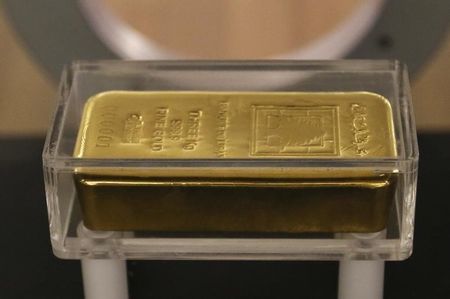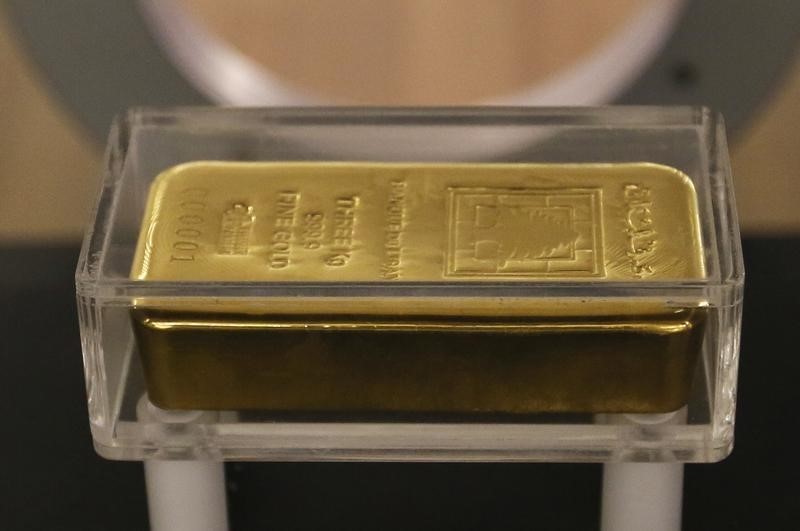Commodities
Gold edges higher, copper muted after China cuts rates


© Reuters.
Investing.com — Gold prices rose slightly on Monday, steadying after steep losses over the past four weeks as markets awaited more cues on U.S. monetary policy, while copper prices were flat after a Chinese interest rate cut missed expectations.
Focus this week is largely on the on Thursday and Friday, where Federal Reserve Chair Jerome Powell is expected to offer more signals on the path of U.S. interest rates.
Gold prices somewhat trimmed recent losses after tumbling below the key $1,900 an ounce level, seeing some safe haven demand as slowing growth in China also weighed on sentiment. The People’s Bank of China largely missed market expectations with changes to its loan prime rate (LPR) on Monday.
rose 0.2% to $1,892.68 an ounce, while expiring in December rose 0.3% to $1,921.95 an ounce by 00:16 ET (04:16 GMT). Both instruments were still trading close to a five-month low.
Jackson Hole, more Fed cues awaited
Gold is expected to trade rangebound in the coming days as investors hunker down ahead of the Jackson Hole Symposium later this week.
Strong U.S. inflation and labor market readings had severely dented gold prices in recent weeks, as markets began pricing in a greater possibility of higher interest rates. Powell is now expected to shed more light on the bank’s plans for rates, after the minutes of the Fed’s July meeting showed that most policymakers supported higher rates to curb sticky inflation.
The and treasury yields advanced on expectations of higher rates, which in turn dented gold and other non-yielding assets. Rising interest rates had ramped up the opportunity cost of holding gold over the past year, leaving most traders sticking to the dollar as their preferred safe haven.
Copper flat as China rate cut disappoints
Among industrial metals, copper prices moved little on Monday even as top importer China disappointed markets with its rate cut.
were flat at $3.7207 a pound.
The PBOC cut its by 10 basis points (bps) to 3.45%, while the was left unchanged at 4.20%. Analysts had forecast a cut of at least 15 bps to each rate.
The move signaled that the world’s largest copper importer has little monetary headroom to keep loosening policy and supporting growth – a trend that could potentially worsen its appetite for the red metal.
Copper imports to China had fallen sharply in July, as a post-COVID economic recovery in the country ran dry. This weighed heavily on copper prices over the past three weeks.
Commodities
Oil prices rise; U.S. crude inventories plunge, Russia-Ukraine truce eyed
Commodities
India’s Reliance to stop buying Venezuelan oil over US tariffs, sources say
Commodities
Oil prices climb on Venezuela supply worries

 Forex3 years ago
Forex3 years agoForex Today: the dollar is gaining strength amid gloomy sentiment at the start of the Fed’s week

 Forex3 years ago
Forex3 years agoUnbiased review of Pocket Option broker

 Forex3 years ago
Forex3 years agoDollar to pound sterling exchange rate today: Pound plummeted to its lowest since 1985

 Forex3 years ago
Forex3 years agoHow is the Australian dollar doing today?

 Cryptocurrency3 years ago
Cryptocurrency3 years agoWhat happened in the crypto market – current events today

 World3 years ago
World3 years agoWhy are modern video games an art form?

 Commodities3 years ago
Commodities3 years agoCopper continues to fall in price on expectations of lower demand in China

 Economy3 years ago
Economy3 years agoCrude oil tankers double in price due to EU anti-Russian sanctions































